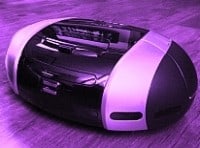
US PRESIDENT ESCAPES SUICIDE ROBOT ATTACK

Kamikaze White House cleaning robot detonates 'battery' bomb
- Dateline
- 11 September 2011
An attempt to assassinate the US President was foiled today by White House security. “At no time was the President in danger,” said a spokesman for the Secret Service, although an aide was injured in the explosion.
Extremist engineers have given a new meaning to the term suicide bomber – now no-one need offer up their life for the cause, just some machinery and electronics.
Following all the successful research and development into autonomous vehicles and robots by the American military, it was just a matter of time before their enemies would use the same technology against them.
It seems the terrorists managed to ‘hack’ a robotic vacuum cleaner by dropping microscopic nanobots on the carpet during a public White House tour. When the cleaning robot ingested these devices, it bypassed the wireless security protocols and programmed its internal lithium-ion batteries to turn into an explosive device.
At this stage it is unclear if the detonation outside the Oval Office was premature or triggered by security measures. Whichever the case, at least catastrophe was avoided.
The question that now has to be answered is this: Is anyone safe from ‘rogue’ robots? We have come to rely on these machines to maintain our lifestyle and standard of living.
But if they are turned against us, how can we trust them?
ANALYSIS >> SYNTHESIS: How this scenario came to be
On the tenth anniversary of the 9-11 attacks there is another attempt on the security of the United States. This time it strikes into the heart of the nation, in the White House itself.
By now the tactic of extremists to use suicide bombers is well established and routinely contained. But what if terrorists turn to the new technology, already adopted by the military to minimize loss of life, and use robots instead?
Like the 9-11 attacks, which used civilian aircraft, using household robots would have an equal chance of avoiding detection. If these appliances are already in place, and contain the basic hardware and chemicals for an explosive device, then (just like the civilian aircraft) half the job is already done. All it needs is to take control and execute the mission.
Rechargeable lithium-ion batteries, which helped to make the mobile-phone revolution possible in the past decade, are now expected to power the increasing electrification of the car. The biggest weakness of lithium-ion batteries is their tendency to become unstable if they are overheated, overcharged or punctured. It’s ironic that, in this age of heightened air security, business people routinely board aircraft with three or more lithium-ion batteries in their hand luggage – cell-phone, iPod and laptop.
The much larger size and energy levels of lithium-ion batteries used to power electric cars poses a dangerous problem. Faulty battery packs could trigger a huge explosion.
2006: Burning batteries
Sony recalls several million laptop batteries because of a manufacturing defect that causes some batteries to burst into flames when charged continuously. YouTube carries a video of a Dell laptop bursting into flames and burning fiercely at a Japanese computer show.
2007: Robot drivers
The DARPA Urban challenge requires autonomous vehicles to drive around an urban environment, even avoiding other traffic. A Carnegie Mellon team wins the robotic vehicle race with an unmanned vehicle, a Chevrolet Tahoe packed with sensors and computer gear called Boss.
The goal of the race is to show that self-driving vehicles can conduct military missions without human assistance. The US wants to use robotic supply trucks to keep soldiers out of harm’s way.
2008: Droids and drones
By 2008 the US military has 4,000 robots in Iraq, mainly small wheeled and tracked devices for inspecting buildings for booby traps and disarming bombs. Robotic vehicles are also proposed for retrieving wounded soldiers under fire and assisting in search and rescue missions, for example in collapsed buildings after earthquakes.
Unmanned aircraft or drones, are also used both for reconnaissance and offensive missions, taking out rebel leaders hiding in Afghanistan.
The Democrats win the US Presidential election.
2009: Lithium hybrid saloon
The Mercedes-Benz S400 BlueHybrid becomes the first production hybrid saloon to use lithium-ion batteries, improving its range and efficiency over its competitors in the same class. The high costs associated with large-scale lithium-ion technology decline as the batteries become more commonplace.
2010: Robot sweepers
Vacuum cleaners like the Roomba and Samsung’s bug-like model are becoming a common sight in homes and public buildings. After all, that’s what robots are really useful for – doing the tedious, repetitive tasks that humans would like to avoid.
2011: Robot bomb
A disaffected robotics engineer conceives a deadly ingenious plan. By producing tiny micro machines with chemical and molecular coding, one can re-program and gain control of a simple cleaning robot.
Extremist opponents of the new president feed these ‘nanobots’ to the unsuspecting carpet cleaner by surreptitiously dropping them on the floor during a public tour of the White House. The robot sucks them up, and is soon conducting its own internal dialog.
This personality change turns it into potential killer. At the right moment, an intentional short-circuit of its powerful lithium-ion batteries causes a moderate explosion. Fortunately the timing is off, and the President is unscathed.
Links to related stories
Warning: Hazardous thinking at work
Despite appearances to the contrary, Futureworld cannot and does not predict the future. Our Mindbullets scenarios are fictitious and designed purely to explore possible futures, challenge and stimulate strategic thinking. Use these at your own risk. Any reference to actual people, entities or events is entirely allegorical. Copyright Futureworld International Limited. Reproduction or distribution permitted only with recognition of Copyright and the inclusion of this disclaimer.